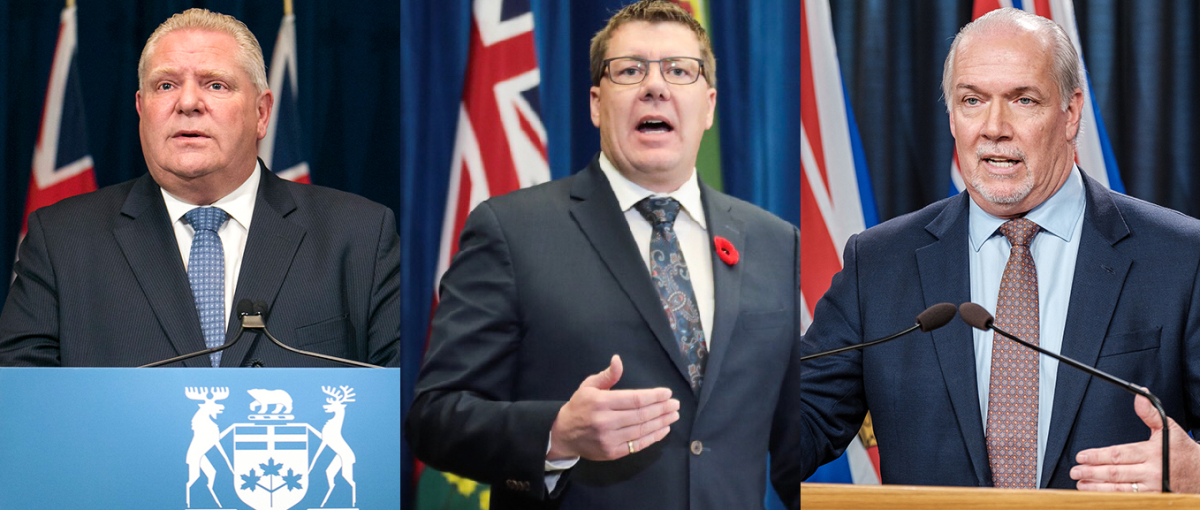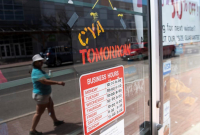Support strong Canadian climate journalism for 2025
Ontario, Saskatchewan and British Columbia launch COVID-19 economic reopening measures this week, and all three provinces are tackling the issue on their own terms.
In Ontario, for example, some outdoor recreation will be permitted, but gatherings of more than five people are still banned. In Saskatchewan, personal services such as hairstylists can reopen, while in B.C. restaurants can offer dine-in service if following a strict health protocol.
Here’s a rundown of some different ways the three provinces are opening up:
Ontario
Canada’s most populous province started the first stage of its reopening plan Tuesday, allowing many retail shops to reopen and residents to resume some outdoor recreational activities.
Plenty of restrictions remain in place, and Premier Doug Ford has extended the province’s emergency orders until May 29 — that means gatherings of more than five people, visits with family and friends outside your household, bars, dine-in restaurants, hair salons and more will remain verboten until the end of next week at least.
On Tuesday, the provincial government said schools would remain shut for the rest of the academic year and also cancelled overnight summer camps.
Retailers with street entrances that are not in shopping malls are allowed to reopen, with physical distancing measures in place.
Recreational activities for individual or single competitors are also allowed, including training and sports competitions by a recognized national or provincial sports organization.
This includes indoor and outdoor competitions for non-team sports that can be played while maintaining physical distancing and without spectators (examples are tennis, track and field and horse racing).
Some outdoor recreational amenities are permitted, including outdoor sports facilities and multi-use fields, off-leash dog areas, and outdoor picnic sites, benches and shelters in parks and recreational areas (playgrounds, fitness equipment, public swimming pools and splash pads remain closed for now).
Pet care services (grooming, training and veterinary appointments) as well as housekeepers, cooks, cleaning and maintenance work are allowed, both indoor and outdoor as long as physical distance is respected.
Drive-in religious gatherings are now OK, if each car includes no more than five people who must be from the same household, cars are two metres apart and the service is not conducted by more than five people who are properly distanced.
Finally, all construction projects, and some health and medical services, such as in-person counselling and scheduled surgeries are allowed.
For more information on the current COVID-19 situation in Ontario, visit covid-19.ontario.ca.
Saskatchewan
Phase two of the Re-Open Saskatchewan Plan is starting on Tuesday, except for the province’s northwest.
Restrictions in Saskatchewan are gradually being lifted in five phases as further information continues to be added to the reopening plan.
Further restrictions were lifted over the May long weekend. As of Friday, golf courses and drive-in theatres were able to begin operations.
Additional restrictions that were put in place for residents in the Northern Saskatchewan Administration District (NSAD) are now limited to the western half of that district, where most new COVID-19 cases are now located. The northeast and north central areas are now on the same reopening schedule as the rest of the province.
The NSAD is a large geographic area that covers almost half the province and accounts for less than four per cent of the population. It is divided into the provincial electoral districts of Cumberland in the northeast and Athabasca in the northwest.
Northwest communities that remain restricted include La Loche, Beauval, Buffalo Narrows, Île-à-la-Crosse and Pinehouse while northeast communities including La Ronge, Air Ronge and Pelican Narrows are now part of the reopening plan.
Beginning Friday, owners and employees of outfitting operations are allowed to travel to outfitting camps, including those in the NSAD.
Outfitters operating south of the NSAD that were not impacted by northern travel restrictions could begin operations as of May 15.
On Tuesday, Saskatchewan had seven new confirmed cases of COVID-19, bringing the provincial total to 599.
According to the Saskatchewan government, businesses that can now begin operation include retail businesses, shopping malls, select personal services such as a hairstylist or barber, as well as public markets and farmers' markets.
In the northwest part of the NSAD, restrictions remain in place. This includes all non-critical travel, including those with primary residences into and out of the NSAD, as well as all non-critical travel between northern communities.
Northwest residents are ordered to remain in their local communities and to practice appropriate physical distancing. Travel related to the delivery of essential services will continue to be permitted.
As of May 20, supply limits on prescription drugs that were introduced to guard against drug shortages will be lifted. The Saskatchewan Health Authority is resuming services such as outpatient physiotherapy appointments, kidney health services, some laboratory services, home care and expanded immunizations.
For more information on the current COVID-19 situation in Saskatchewan, visit www.saskatchewan.ca/COVID19.
British Columbia
B.C.’s four-phase Restart Plan sees the province opening a range of businesses under detailed new WorksafeBC protocols that were released on Friday for each industry sector.
The province never aggressively moved to disperse all public gatherings as much as some others. B.C. banned gatherings of more than 50 people, a number that is much larger than Ontario’s ban, for example, on gatherings of more than five people not from the same household, or Alberta’s ban on more than 15 people in one indoor location.
But provincial health officer Bonnie Henry also told B.C.ers back in March that “all gatherings are off the table,” and has portrayed the limit of 50 as a ceiling. B.C. also began advising those returning from abroad to self-quarantine earlier than the federal government did.
The impact on businesses has still been severe, with 41 per cent of businesses in an April 21 BC Chamber of Commerce survey reporting that they laid off employees, and almost a quarter having to close temporarily.
The list of businesses allowed to reopen this week includes everything from dine-in restaurants, cafes, and pubs to museums, art galleries and libraries, offices, health services, counsellors, dentists, therapists, chiropractors, hair salons, sports and child care.
The 1,200-word safety protocol for dine-in restaurants, for example, includes requirements for posting COVID-19 safety plans, and limits capacity to 50 per cent at one time, with no table having more than six people, and tables spaced two metres apart.
The protocol also includes a playbook for servers, to do things such as remove one chair per table, and use the space to take orders or place food and drinks, letting guests pass them around themselves and pour their own water. Condiments such as salt and pepper should be removed and menus should be disposable or digital.
As well, employers, “if practicable,” are required to “retain the contact information for one member of every party” for 30 days in the event that the government needs to conduct contract tracing following a virus outbreak. They should also stagger break times and provide hand sanitizer, put floor decals to show distancing and develop handwashing procedures, among other measures.
Last week Henry said the Phase 2 guidelines should be cautiously heeded, so people only expand their social circles slightly, keep visits short and outside if possible, and continue practicing physical distancing, washing hands, not touching your face and avoiding sharing any food or drinks.
For more information on the current COVID-19 situation in British Columbia, visit gov.bc.ca/covid19.
Carl Meyer / Local Journalism Initiative / Canada's National Observer
Michael Bramadat-Willcock/Local Journalism Initiative/Canada's National Observer







Comments